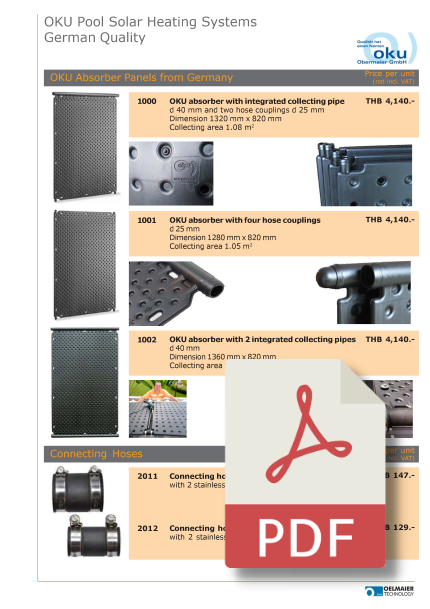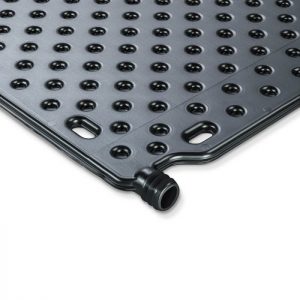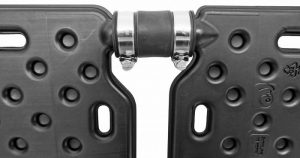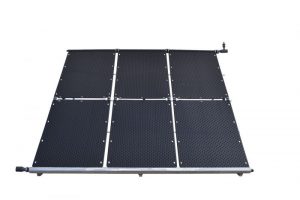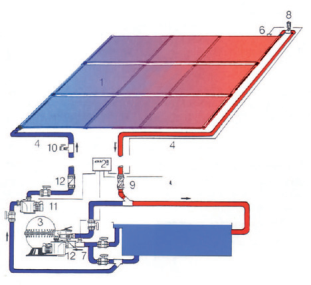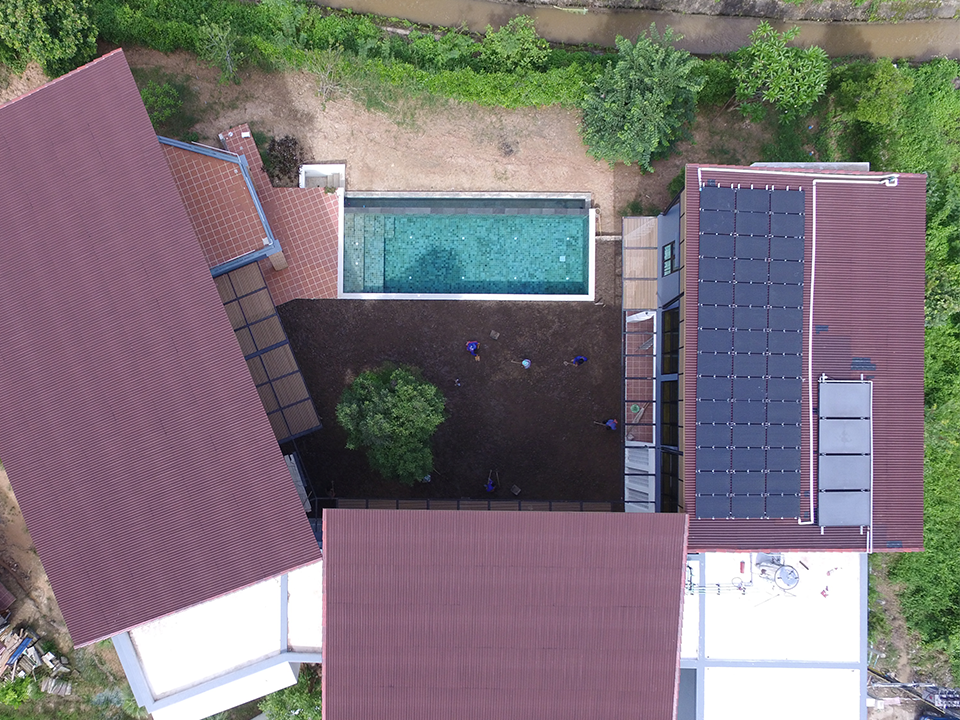
The climate in northern Thailand is very pleasant during the winter season. But outdoor swimming pools are quite uncomfortable during the cold season, if not heated. An indoor pool has to be heated nearly all year round, even in the hot season. Heating of swimming pools is an ideal application for solar energy. Not very high temperatures are needed, but large quantities of water have to be heated, so it make sense to operate such an installation with a large flow rate at relatively low temperature level.
THE POOL HEATING PANELS
The solar pool heaters for pools are enjoying increasing popularity. They are extremely efficient, inexpensive to purchase and can some time be operated with the existing pool filter pump, but a small circulation pump operated by a differential temperature controller makes it very efficient!
The solar mats absorb the solar radiation and transfer the heat gain directly to the pool water. It makes sense to operate the pool heating with a large flow rate at a relatively low temperature level. In this way, you achieve optimum efficiency with your solar system.
OKU absorbers for solar pool heating are absolutely frost-proof and therefore also suitable for installation on flat roofs. The solar absorbers are chemical-resistant, salt water-resistant, easy to assemble and suitable for self-assembly. In addition, the absorbers made of HDPE are 100% safe against animal bite.
The OKU solar absorber contains high molecular weight polyethylene. Suitable for installation to generate warm water for the pool from solar energy It has been in development since 1975. A long period of time is the guarantee of the quality of the product.
OKU absorbers can be categorized into three types according to their installation style. Each type of OKU absorbers is used according to the installation design. To suit the needs of hot water compared to the amount of water in the pool. Item no.1000 is suitable for installing Solar Pool Heating Systems with 2 rows or more, with one side connected to the water pipes for water circulation. In the pool, Item no.1001 is suitable for installations that have more rows. Because it looks like a connector They are often used for installation together with Item no.1000 for more efficient operation and Item no.1002 are absorbers with welded pipes to circulate water in both upper and lower pools. Single row It should be designed and installed by someone with expertise
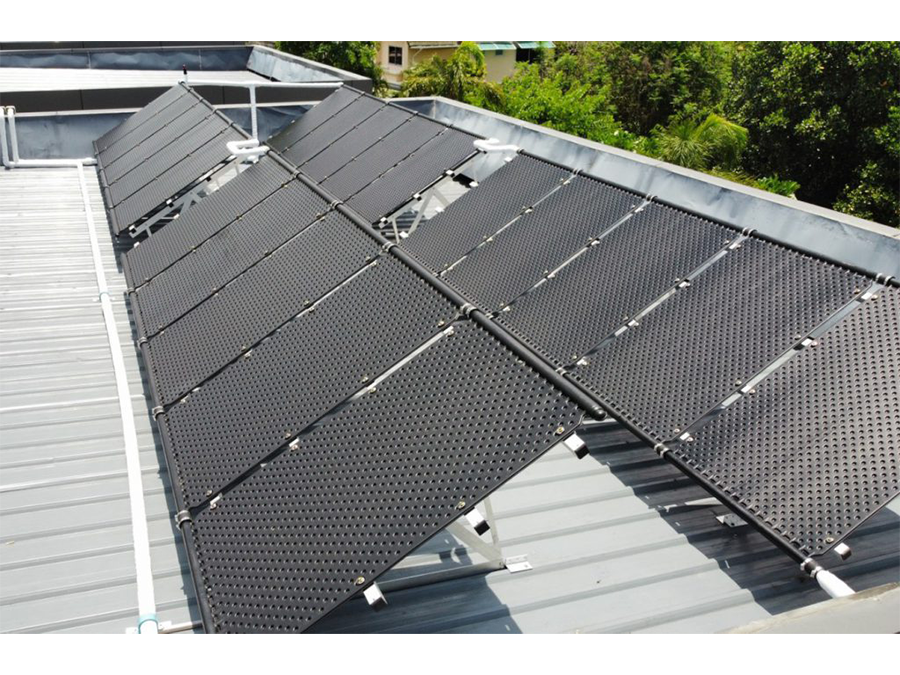
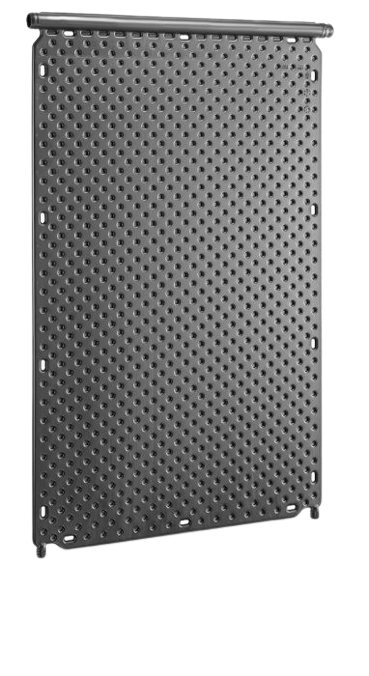
Item No. OKU 1000
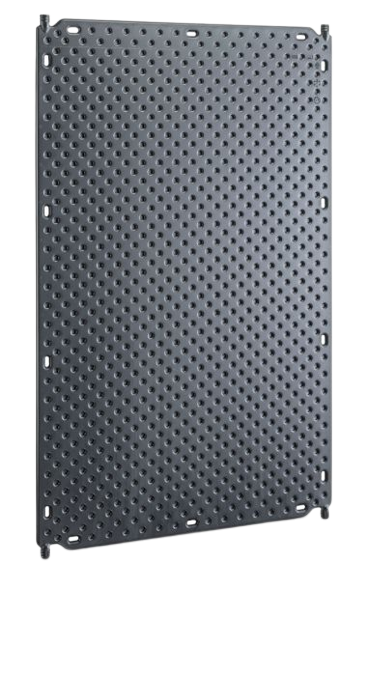
Item No. OKU 1001
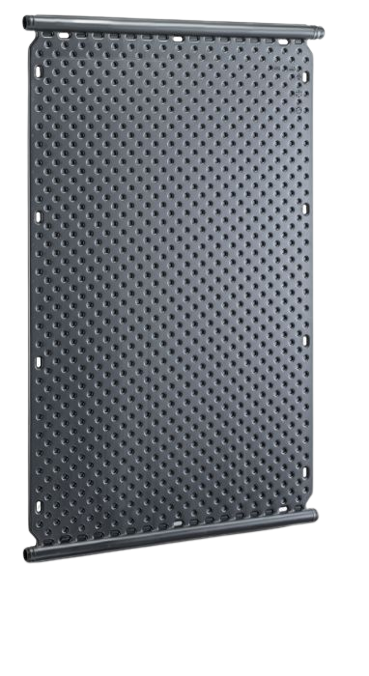
Item No. OKU 1002
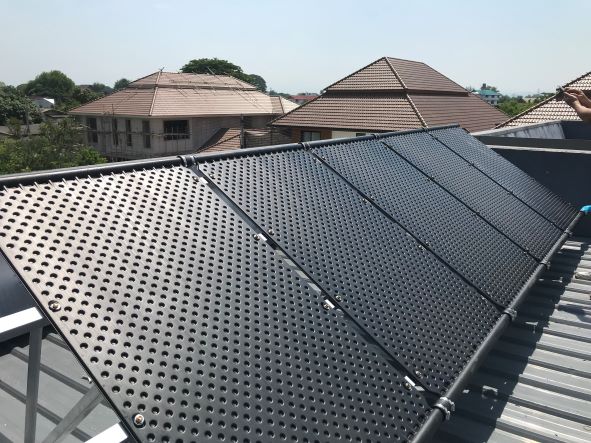
- Low pressure drop, approx. 0.003 bar at 200 l/h/m²
- Flow rate 150 to 250 l/m²/h
- Molded in one piece, homogeneous black
- Weight approx. 6 kg/m², water content 6 l/m²
- Testing pressure 4.5 bar at NT
- Working pressure up to 1.2 bar – 40°C
- Efficiency up to approx. 80% – power up to 0.8 kWh/m²
- Average value 0.5 to 0.6 kWh/m²
- Non-corroding, resistant to swimming-pool water chemicals
- Pool water pumped direct through absorber
- Idling proof
- Temperature resistant from -50 to + 115°C
- Full area through ascendable, supports human weight
- Modular assembly system, easy to install
The swimming pool water can be the OKU -Absorbers in every direction flow through. The assembly is both lengthwise and widthwise possible. Connection of the individual rows of absorbers according to Tichelman (same Routes for each row). We recommend no more than eight absorbers to connect in series. interpretation Recommended absorber area in% of the pool area for outdoor pools with cover or indoor pools (early May to late September). Temperature increase 4-7 ° C compared to unheated swimming pools.
If there is no cover, the absorber area should be 50% larger will. The regionally varying hours of sunshine can be increased with or Discounts of up to 20% of the absorber area can be taken into account. Pump performance A flow rate of 150 to 250 l / m2 absorber area per hour is recommended. The required pump type can easily be determined. The delivery rate is calculated from the absorber area x 200 l. The funding amount results from the height difference between the water level and the absorber field plus approx. 5 m surcharge.
This configuration can usually be selected if the absorbers are not to be set up higher than 6 m above the surface of the water.
A three way motor ball valve has to be integrated into the pressure line of the filter installation. Because of a differential-temperature regulation the ball valve is operated whenever the absorber temperature is higher than the temperature of the water of the swimming pool. The filter stream is then pumped through the absorbers. The warmed water flows back into the filter circuit by a T-junction. This configuration is suitable for large pools where the filter pump is operated all day long.
In many cases it may be sensible or even necessary to install a separate circulation pump for the solar heating. For example if the absorbers are to be set up higher than 6 m above the surface of the water.
For small pools and also to save energy the filter may operates only for limited periods during the day, while the water heating should circulate whenever the sun shines. The water is diverted from the filter installation by a T-junction and pumped through the absorbers by the auxiliary circulation pump. This pump is switched by the differential temperature regulation to ensure that it only runs to actually win energy. It is usually advisable to integrate non-return valves in both the solar and the filter circuit.
This configuration is chosen when the filter piping is difficult of access. The water is sucked out of the swimming pool by an immersion pipe, pumped through the absorbers, and the warmed water is conducted back into the swimming pool. Here too the differential temperature regulation ensures that the circulation pump only runs to win energy. If the pump is mounted above the water level and the delivery head is more than 5 m, a non-return valve should be incorporated.
However, there are many options to control the circulation pump (e.g. by a light sensor which only operates at intense light or by an thermostat switch in one of the last panels in the cycle.)
- Oku absorber
- Differential temp. regulator
- Filter installation
- Solar circuit forward/return
- Three-way motor ball valve
- Temperature sensor, absorber
- Temperature sensor, pool
- Air vent
- Stop cock (downdraft brake)
- Drain cock
- Circulation pump
- Non-return valve
SIZE OF POOL HEATING SYSTEM
The recommended absorber area is about 50%-70% of the pool surface area. If the pool is covered with tree or building shade, it may need up to 70% of the pool surface area. An output water temperature increase of about 4-7°C compared to unheated swimming pools. The size of the swimming pool allows you to calculate the required OKU absorbers for your pool heating system. Each absorber panel has about 1.1 m² area. For example, 4.5 m long with 2.5 m wide swimming pool has 11.25 m² area. So the required area of absorber is about 5.625 to 7.875 m² which approximately equals 5 to 7 panels of OKU absorbers.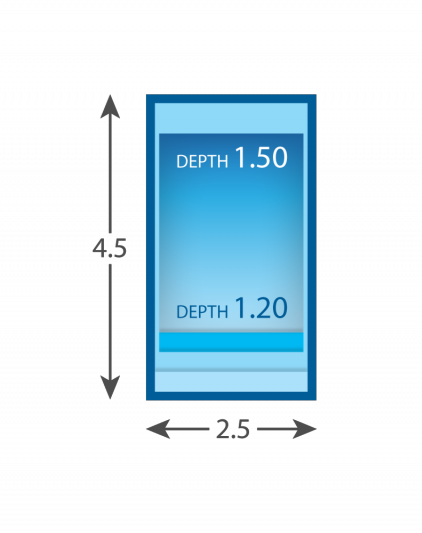
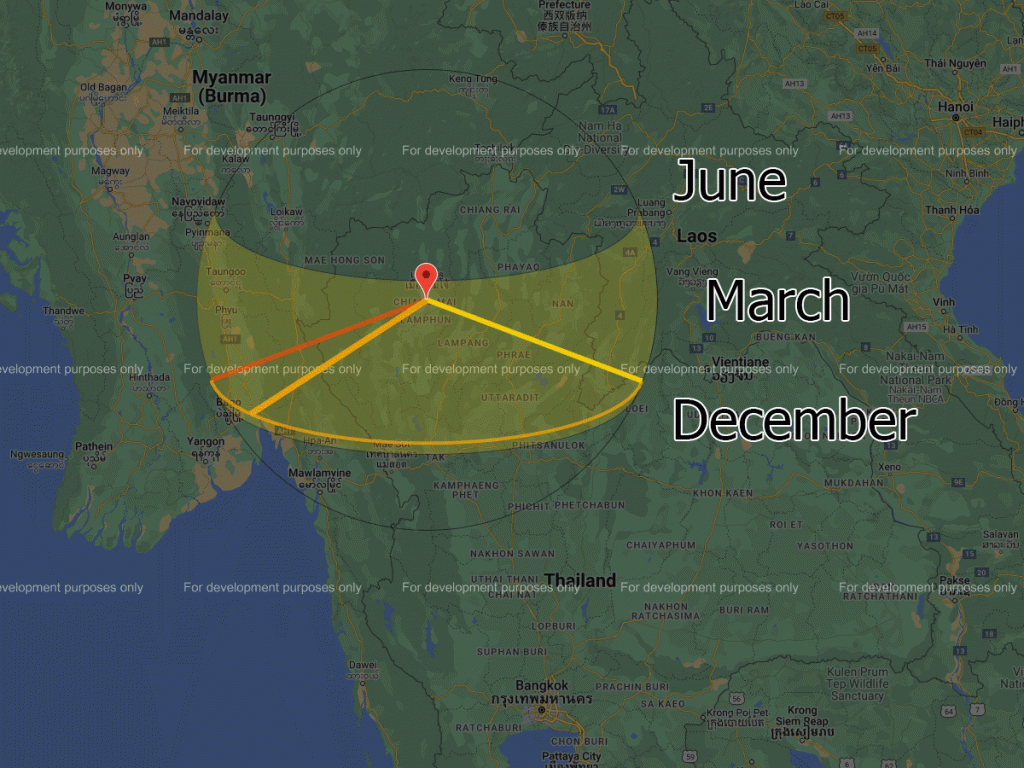
OKU absorbers receive the most power when are tilted at an angle equal to the latitude of your city.
For example, if you live in Chiang Mai, whose latitude is 18.8 degrees North, you’d want to tilt your array about 18.8 degrees up from the ground for best results. The angle at which an array is tilted off its surface mounting is known as the array tilt angle. If you you’re using a flat mounting surface (e.g. a ground mount or carport), you’ll need tilted racks that can be adjusted to about 18.8 degrees.
OKU panels should face as close to true south as possible.
Whereas the array or roof tilt angle involves an altitude or vertical measurement, there’s also the compass direction to consider. As stated earlier, true south is considered the ideal orientation for a fixed-panel array. That’s because the sun spends its peak hours in the south shining down on the Earth. This compass direction is referred to as the solar azimuth angle.
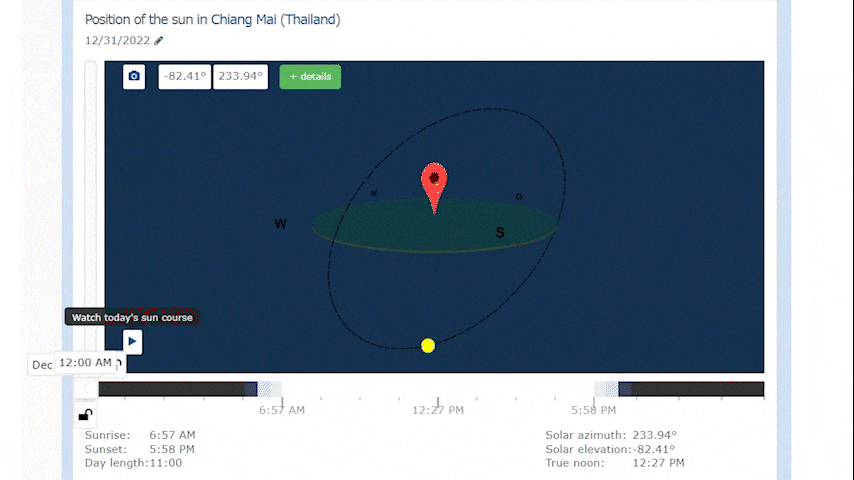
Despite solar radiation efficiency depends on time and season, but it is good to install panels on your roof if it has 10°-30° of inclination angle. The lost from small change in orientation doesn’t significantly appeared because solar water collectors have generally a very high efficiency of about 92% to 96%. So the final efficency is evenly very great value.
Because during winter time you need more hot water than in summer, 30° is the most suitable solar absorber elevation for this situation, despite it’s not the best efficiency point. But it is the best solution.
We have the perfect solar energy solution for you
Strong energy engineering knowledge. High standard staff and service. Top reliability.
